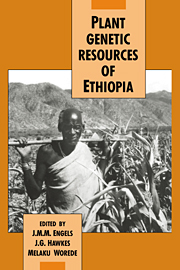Book contents
- Frontmatter
- Contents
- Contributors
- List of acronyms
- Preface
- Part I General introduction
- Part II The Ethiopian centre of diversity
- 2 The Ethiopian gene centre and its genetic diversity
- 3 Crops with wild relatives found in Ethiopia
- 4 Diversity of the Ethiopian flora
- 5 Forest genetic resources of Ethiopia
- 6 Plants as a primary source of drugs in the traditional health practices of Ethiopia
- 7 Traditional aromatic and perfume plants in central Ethiopia (a botanical and ethno-historical survey)
- 8 Spice germplasm in Ethiopia
- 9 A diversity study in Ethiopian barley
- 10 Sorghum history in relation to Ethiopia
- 11 Prehistoric Ethiopia and India: contacts through sorghum and millet genetic resources
- 12 Konso agriculture and its plant genetic resources
- Part III Germplasm collection and conservation in Ethiopia
- Part IV Evaluation and utilization of Ethiopian genetic resources
- Index
10 - Sorghum history in relation to Ethiopia
Published online by Cambridge University Press: 30 October 2009
- Frontmatter
- Contents
- Contributors
- List of acronyms
- Preface
- Part I General introduction
- Part II The Ethiopian centre of diversity
- 2 The Ethiopian gene centre and its genetic diversity
- 3 Crops with wild relatives found in Ethiopia
- 4 Diversity of the Ethiopian flora
- 5 Forest genetic resources of Ethiopia
- 6 Plants as a primary source of drugs in the traditional health practices of Ethiopia
- 7 Traditional aromatic and perfume plants in central Ethiopia (a botanical and ethno-historical survey)
- 8 Spice germplasm in Ethiopia
- 9 A diversity study in Ethiopian barley
- 10 Sorghum history in relation to Ethiopia
- 11 Prehistoric Ethiopia and India: contacts through sorghum and millet genetic resources
- 12 Konso agriculture and its plant genetic resources
- Part III Germplasm collection and conservation in Ethiopia
- Part IV Evaluation and utilization of Ethiopian genetic resources
- Index
Summary
Introduction
Hypotheses on crop development in Africa are long on theory and short on fact. Let me present my own ideas. Harlan & Stemler (1976) have presented a theory that sorghum developed in the southern Sudan–Chad region. My problem with that is the answer to the question ‘how’? It is true that as soon as Man began to sow the seeds of wild grasses, selection and sowing over the years would result in cultivated types being developed. That assumes that Man somehow learnt the idea of agriculture. Perhaps he did, but it is not clear how this happened in the rainfed savannahs. There were lots of grasses there anyway, and lots of grass seed. Why sow more? How would man have learnt to sow seed? How would he have distinguished between the masses of grass seedlings coming up with the rains and those which he had put in? By clearing a separate plot of land for sowing? That presumes the idea of agriculture. Having worked in the tropics for many years, I find this altogether too difficult to imagine.
It is more likely, to my mind, that agriculture was discovered along rivers and that the discovery was a rather rare event. One should always look at the possibility of the spread of the idea of agriculture from elsewhere before concluding that it had been discovered all over again. My scenario for the discovery of agriculture in a situation of this kind is presented below.
- Type
- Chapter
- Information
- Plant Genetic Resources of Ethiopia , pp. 140 - 159Publisher: Cambridge University PressPrint publication year: 1991
- 15
- Cited by



